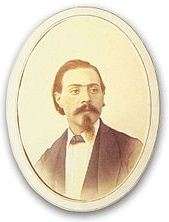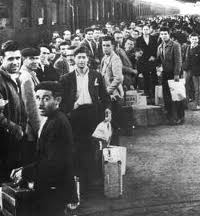Italian Colombian
| |
|---|---|
| Regions with significant populations | |
| Bogotá, Atlantico Department, Antioquia Department, Norte de Santander Department, Valle del Cauca Department | |
| Languages | |
| Colombian Spanish · Italian and Italian dialects | |
| Religion | |
| Roman Catholicism · Protestantism (Lutheranism · Evangelicalism) · Judaism |
.jpg)
Italian Colombians (Italian: Italo-colombiano, Spanish: Italo-colombiano) are Colombian citizens of Italian descent. The word may also refer to someone who has emigrated to Colombia from Italy.[1] The term "Italian" may refer to ethnic Italians. Most Italian Colombians live in Bogotá, Antioquia Department, Santander Department and other highland cities, where the climate is temperate and similar to that of Italy. Italians have been immigrating to Colombia since at least the 15th century.
History
During Gran Colombia and Republic of Granada
Very few Italians arrived in Colombia before the war of independence led by Simón Bolívar, although several hundred monks came from Italy primarily as priests and missionaries were present in the country and have left their mark in many lines of colonial society. Although few, these early Italians were present in almost all higher levels of Colombian society: in 1812 Juan Dionisio Gamba, the son of a merchant from Genoa was president of Colombia.
In the mid-nineteenth century, many Italians arrived from South Italy (especially from the province of Salerno, and the areas of Basilicata and Calabria), arrived on the north coast of Colombia: Barranquilla was the first center affected by this mass migration.
One of the first complete maps of Colombia, adopted today with some modifications, was prepared earlier by another Italian, Agustín Codazzi, who arrived in Bogota in 1849. The Colonel Codazzi also proposed the establishment of an agricultural colony of Italians, on model of what was done with the Colonia Tovar in Venezuela, but one factor prevented it.

In 1885 diplomatic relations for some years between Italy and Colombia were interrupted. When a wealthy businessman in the Italian-Colombian Cauca named Ernesto Cerruti- was placed against the oligarchy and the church favoring a liberal party and local mason, Bogota authorities confiscated their property and imprisoned. This has caused a blockade of the port by the Colombian Navy and Italian emigration in Italy was partially closed until 1899.
In November 1887 to commemorate the independence of Cartagena, has been interpreted in Bogota's "Variety Theatre" a fervent song with lyrics from Rafael Núñez, which was subsequently adopted by the Law 1920 as 'Hymn of the Republic of Colombia'. It came from an Italian who had arrived as first tenor in an opera company, the Italian musician Oreste Sindici (May 31, 1828 – January 12, 1904), and who lived the last years of his life in Bogotá well acclaimed by the Colombians.
He was an Italian-born Colombian musician and composer, who composed the music for the Colombian national anthem in 1887.
Oreste Sindici died in Bogotá on January 12, 1904 due to severe arteriosclerosis. In 1937 the Colombian government honored his memory.[2]
World War II
After the Second World War, Italian emigration to Colombia was directed primarily toward Bogota, Cali and Medellin. Only a few thousands moved to Colombia and many of them later moved to nearby Venezuela (where there was an economic petro-related boom that attracted millions of Colombians in the 1950s and 1960s).
Italian emigration to Colombia
Approximately 30,000 Italians have emigrated to Colombia since colonial times. It is calculated, by the Italian Embassy in Bogota, that in 2010 more than 120,000 Colombians have direct or distant roots in Italian emigrants. Actually 14,216 Italians are residents in Colombia (2011 "Anagrafe Italiani iscritti estero - AIRE")


Italian emigrants by Italian Region
| Region | Percentage |
|---|---|
| Veneto | 26.6% |
| Campania | 12.1% |
| Calabria | 8.2% |
| Lombardy | 7.7% |
| Tuscany | 5.9% |
| Friuli-Venezia Giulia | 5.8% |
| Trentino-Alto Adige/Südtirol | 5.3% |
| Emilia-Romagna | 4.3% |
| Basilicata | 3.8% |
| Sicily | 3.2% |
| Piedmont | 2.8% |
| Apulia | 2.5% |
| Marche | 1.8% |
| Molise | 1.8% |
| Lazio | 1.1% |
| Umbria | 0.8% |
| Liguria | 0.7% |
| Sardinia | 0.4% |
| Aosta Valley | 0.2% |
Language
Italian immigrants have integrated easily into the Colombian society. Today the vast majority of their descendants only speak Spanish, the national language of Colombia. Approximately 24% of the native descendants still speak (or understand a little) the Italian in 2008.
Culture
Music
The Italian influence in Colombia reached also the music, not only with traditional Italian songs but also with the merging with other Colombian music styles.
Food
Italians brought new recipes and types of food to Colombia but also helped in the development of Colombian's cuisine. Spaghetti and pizza are some of the favorite foods in actual Colombia thanks to them.
See also
References
- ↑ A game of mirrors: the changing face of ethno-racial constructs and language in the Americas. Thomas M. Stephens. University Press of America, 2003. ISBN 0-7618-2638-6, ISBN 978-0-7618-2638-5. Retrieved on 2010-10-14.
- ↑ "Símbolos patrios de Colombia" (in Spanish). Presidencia de Colombia. Archived from the original on March 9, 2012. Retrieved November 1, 2010.